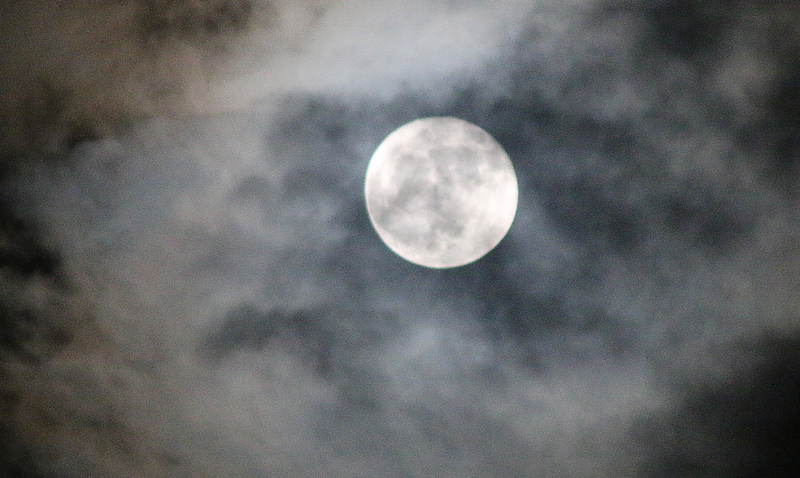If you are fortunate enough to be at a location in North America or South America with clear skies — or if you are traveling to that location — get ready to view the peak of a super blood wolf moon eclipse, which begins at 12:16 in the morning Eastern Standard Time on Monday, January 21, 2019 and will last for one hour and two minutes.
View the Super Blood Wolf Moon Eclipse of 2019
The full experience — from the start of the partial lunar eclipse to the end — will last a total of three hours and 17 minutes; and it is scheduled to start at 10:34 in the evening Eastern Standard Time on Sunday, January 20, 2019…
…and this celestial event — in which the full moon will become fully tinted with the reddish-orange color of sunset — is the only total lunar eclipse of 2019. It will be the last total lunar eclipse until Wednesday, May 26, 2021, which will be visible over the Pacific Ocean, with viewing possibilities in North America, South America and east Asia; and the last one visible from the United States until the year 2022.
This particular total lunar eclipse will occur at its perigee, which is when the moon is at the point in its orbit where it is closest to Earth.
The peak of a total lunar eclipse is also known as the greatest eclipse and is defined as the moment when the moon comes closest to the axis of the shadow of the Earth. A blood colored moon is created by a combination of ash from fires and volcanoes, dust storms, and pollution — all of which filter sunlight as it scatters around the world; while a grey eclipse is the result of clear skies.
Additional Information
Additional information pertaining to a total lunar eclipse — including the bast ways to view it — is provided by this article written by for Space.com, which includes timetables for watching the lunar eclipse from select locations around the world:
- Learn more about what makes lunar eclipses so special.
- It is the last total lunar eclipse until 2021!
- You can use mobile astronomy mobile software application programs to get the most of your views!
- The stages of the blood moon to look for
- How to watch the eclipse online
- How to share the eclipse with your kids
- The stages for which to look
- A photography guide for the eclipse from the European Space Astronomy Centre in Spain
- Here is the Weather Forecast for the Super Blood Wolf Moon of 2019 Tonight!
The National Weather Forecast for the lunar eclipse tonight (Jan. 20) is basically a coin toss. - Super Blood Wolf Moon of 2019! Visibility Maps for the Total Lunar Eclipse
See visibility maps for the Super Blood Wolf Moon eclipse of 2019 here!
Lunar Eclipses
According to this article edited by Flint Wild for the National Aeronautics and Space Administration of the United States — which is more popularly known as NASA — “the moon moves in an orbit around Earth, and at the same time, Earth orbits the sun. Sometimes Earth moves between the sun and the moon. When this happens, Earth blocks the sunlight that normally is reflected by the moon. (This sunlight is what causes the moon to shine.) Instead of light hitting the moon’s surface, Earth’s shadow falls on it. This is an eclipse of the moon — a lunar eclipse. A lunar eclipse can occur only when the moon is full.”
Two types of lunar eclipses — total lunar eclipses and partial lunar eclipses — can be seen from Earth at night. When a lunar eclipse begins, the bright moon dims as it enters the outer part of the shadow of the Earth, which is called the penumbra. The deep tint of a full lunar eclipse is visible once the moon enters the deepest part of the shadow of the Earth, which is known as the umbra. The bright-red color appears once the moon is fully engulfed in the shadows — which is the reason blood moon is a popular term for lunar eclipses.
As for why this moon is called a Wolf Moon, which is the traditional name for the full moon in January, “This full Moon appeared when wolves howled in hunger outside the villages. It is also known as the Old Moon”, according to this article pertaining to the names for full moons from The Old Farmer’s Almanac. “To some Native American tribes, this was the Snow Moon, but most applied that name to the next full Moon, in February.”
A total lunar eclipse — which is rare — occurs during a full moon at a time when the moon and the sun are on exact opposite sides of Earth. Although the moon is within the shadow of the Earth — and its facade changes from being bright to becoming a dark red or rust color — some sunlight still reaches the moon. The sunlight passes through the atmosphere of the Earth at a particular angle and scatters, which filters out most of the blue light and usually results in the moon appearing to be red in color to people on Earth — similar to the red and orange colors of sunset and sunrise.
If you stood on the moon during a total lunar eclipse, Earth would appear to have a reddish ring all around it, as you would gaze at the 360-degree sunrise and sunset you would perceive at that particular intersection of the orbits of the Earth and its moon.
A partial lunar eclipse — which occurs at least twice per year — happens when only a part of the moon enters the shadow of the Earth. During a partial lunar eclipse, the shadow of the Earth appears to be very dark on the side of the moon facing Earth. What people see from Earth during a partial lunar eclipse depends on how the sun, Earth and moon are lined up.
“A new moon occurs roughly every month, when the moon’s far side is facing the sun and the moons near side is in darkness”, according to the aforementioned article from Space.com. “Every time a viewer sees the moon, it’s always the same face, because the moon is tidally locked with Earth. So, when the moon is between the sun and Earth, a viewer doesn’t see the near side; it cannot be seen in the sky. New moons are the phases that produce the other major celestial-shadow event: solar eclipses.”
A lunar eclipse occurs during the phase of the full moon, which is the opposite phase to the new moon. During lunar eclipses, the Earth is positioned in the middle between the sun and the moon — which is how the moon is able to pass through the shadow of the Earth.
Summary
I plan on viewing the super blood wolf moon eclipse tonight — which is different from a full lunar eclipse on a super blue blood moon, which occurred almost one year ago — despite the frigid conditions which have been forecast for most of the eastern half of the United States…
…but as spectacular as the total lunar eclipse promises to be, I know it will pale in comparison to the total solar eclipse which I experienced on Monday, August 21, 2017:
- Nothing I Can Do, A Total Eclipse of the Sun
- Total Solar Eclipse: Two Useful Tools to Know Where to Go
- Everything You Do Not Want to Know About Trying to View a Total Solar Eclipse
- Photographs of the Total Eclipse of the Sun
Photograph ©2017 by Brian Cohen.

